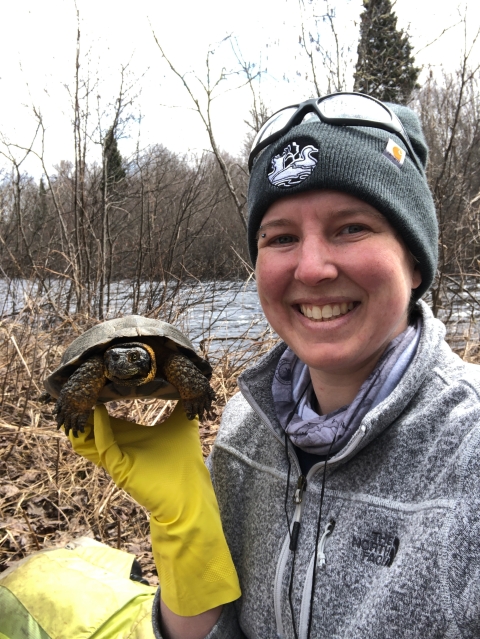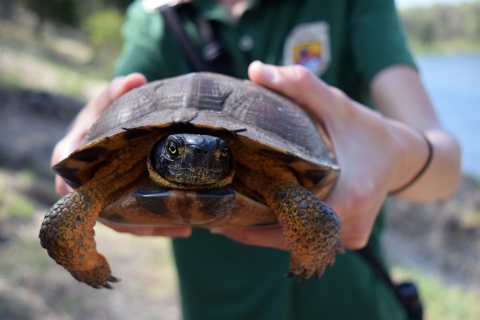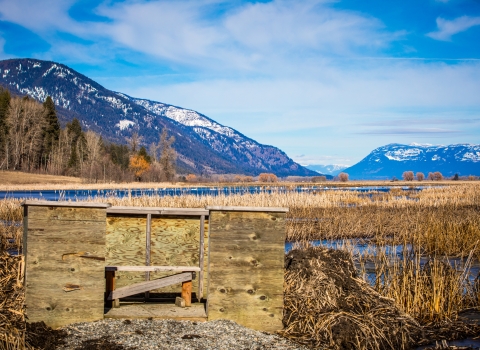When a forester fells a tree and yells, “Timber!” would you believe they’re also thinking, “Wood turtle!”? In the working forests of Michigan, they are! We at the U.S. Fish and Wildlife Service are proud of our partnerships across sectors, including the world of forest timber. Take a moment to learn how species conservation and the timber sector are working together in Michigan.
Wood turtle profile – Would you swipe right to protect?
Meet the wood turtle, a scrappy reptile who settles into chilly waters for brumation – the scientific term for hibernation in reptiles – during midwestern winters. In the summer, this little guy spends his days in the forest searching for berries and a good place to sunbathe. Wood turtles can live for 80 years, but don’t be fooled, they know how to party. They keep their feet loose by doing the worm stomp: a dance done to imitate rainfall and draw worms out of their burrows.
Found in woods and waters from Maine to Minnesota this semi-aquatic turtle, like so many species, has experienced habitat loss and degradation. Every day, they encounter dangerous road crossings, polluted waters, nest predation and capture by poachers. While we know wood turtle populations in the northeastern states are declining, health of populations in the midwest are less understood. Luckily, Trish Brockman, a current graduate student in the Department of Fisheries and Wildlife at Michigan State University, is on it.
In 2020, Brockman was recruited by the Wildlife Conservation Initiative to research the way wood turtles use forests with timber harvest, called working landscapes. The initiative is a formal partnership among the U.S. Fish and Wildlife Service, National Alliance of Forest Owners and National Council for Air and Stream Improvement, Incorporated. The partners work together to conserve species on private working forests.
The old souls of the forest
Since the start of her graduate research, Brockman has developed a fan-girl attitude forthis native reptile.
First, Brockman needed to find out exactly how her subjects used the forest. Like paparazzi for the local turtles, she followed as they foraged for berries and frequented the best sunbathing logs. While learning about their use of the land, she gained an appreciation for their individuality. Brockman began to see these turtles as “old souls” with routines, personalities and preferences. They have great memories. She says, “they know the forest like the back of their…well shells, I guess.”
Harvest timber, not turtles
As Brockman examined the relationship between wood turtles and working forests, she found that the two can coexist.
“Forest management isn’t just about chopping down trees,” said Brockman. “It’s about creating a healthy forest that works for wildlife, economic factors and people.”
Henning Stabins, a wildlife biologist for a private forest products company, agrees wholeheartedly. “It’s all about being proactive,” he says, “We want to address endangered and at-risk species, but we also want to keep common species common.” Stabins says it can be tricky to care for species of conservation concern, such as wood turtles. Species who are particularly at risk, are listed on the Endangered Species Act and are given special considerations. With 29 years of experience to learn from, he’s found it’s easier to conduct research proactively and conserve species, like the wood turtle, before they are listed.
Brockman shares the knowledge
Brockman expanded her work to host “Wood Turtle 101” workshops with foresters wanting to learn more. “You can write all the scientific papers you want,” Brockman explains, “but if you can’t communicate to the folks who are doing the work, you can’t be effective.”
Foresters who attended the workshop found creative ways to help the turtles. They rescheduled harvest to avoid logging during active turtle season and are thinking of ways to construct and maintain sites to improve nesting success. With the wood turtle’s home range being a near perfect reflection of the privately managed forests that cover more than 60% of Michigan, their support is making a big difference.
Friends across sectors
Brockman is still receiving pictures and locations of wood turtles from enthusiastic foresters. She is amazed by their level of engagement, and it gives her hope for the wood turtle’s future. With support from our agency and the initiative, these two unlikely groups have found friends across sectors.
We've seen how these efforts are compounded beyond our individual capacity when we collaborate with other organizations. These voluntary partnerships continue to bring innovation, stewardship and meaningful engagement to the field of conservation.






